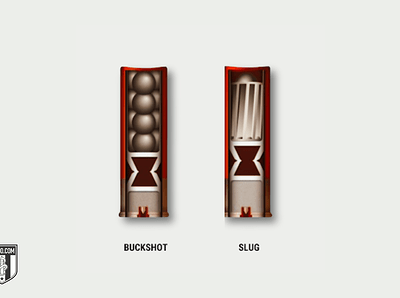The 12 Gauge shotgun is considered by many to be one of the most versatile firearms, as it is suitable for hunting and defense alike. A 12 Gauge shotgun’s stopping power is tremendous, offering homeowners, hunters, and law enforcement officers a potent solution for close- and long-range engagements.
Many newer shotgun owners wonder which type of ammo they need: buckshot, or slugs? A load of buckshot is devastating at close range, whereas a slug allows target engagement at longer ranges. Both types of shotgun ammo are effective for harvesting big game and self-defense, but electing the right ammo is critical to success. That’s why this article lays out the relative pros and cons of buckshot vs. slugs. Read it and know which is better for your shooting needs!
The Difference Between Buckshot and a Slug Explained
The difference between buckshot and a shotgun slug is simple. Buckshot is multiple projectiles: lead balls typically ranging from 0.24 to 0.36 inches in diameter. Conversely, a slug is a single projectile: usually made of lead (sometimes copper or other metal), which performs similarly to a rifle bullet. Buckshot is effective at closer ranges (usually within 50 yards), whereas a standard rifled slug is effective out to 100 to 150 yards.
| Feature | Buckshot | Slug |
|---|---|---|
| Projectiles | Multiple lead balls per shell | Single solid projectile |
| Pattern | Pattern spreads to increase probability of hit at close range | No spread |
| Effective Range | Typically effective within 50 yards | Typically effective within 100 - 150 yards |
| Best For | Close-range hunting, home defense, moving targets | Medium-to-long range hunting, slug-only hunting zones, precision at distance |
Understanding Buckshot
As its name implies, buckshot is intended for hunting medium and large game. In addition to bucks, it’s commonly used for taking hogs and coyotes.
Buckshot pellets are larger than birdshot. The largest birdshot pellet is 0.22 inches in diameter. If it’s any wider than that, it’s buckshot. Buckshot loads usually contain more powder than upland hunting or target loads, which contributes to buckshot’s longer effective range and higher damage potential.
When you pull the trigger on a Remington 870 12 Gauge shotgun, the pellets begin spreading out shortly after exiting the barrel. At close range, buckshot hits in a dense pattern to wreak maximum destruction. It’s common for a 12 Gauge buckshot shell to hit with the power of a .308 Win hunting rifle cartridge, albeit spread out over eight or more points of impact.
The picture below will help you understand how shot size relates to the pellet diameter.
Understanding a Shotgun Slug
A slug is a single large projectile designed to be fired from a shotgun. There are two major types of shotgun slugs: rifled (designed to be fired through a smoothbore barrel), and sabot (designed to be fired through a rifled barrel).
The major advantage of using a slug over buckshot is that a slug extends the effective range of a shotgun significantly. Using only a bead sight, you can accurately fire a rifled slug out to 50 to 75 yards. With a scope, you can reach even farther.
A slug will not accurately cover the same kind of distances as most rifle bullets, although it can extend a shotgun’s effective range approximately two to three times farther than buckshot.
A 1 ounce (i.e. 437.5 grain) 12 Gauge slug has a diameter of approximately 0.729”. That’s going to leave a big hole in whatever it hits! A slug will also penetrate deeper into its target than buckshot. It’s heavier, and therefore conserves more momentum after impact.
Continue reading Buckshot vs. Slug: What’s the Difference Between These Shotgun Shells? on Ammo.com!
https://ammo.com/comparison/buckshot-vs-slug#shotgun-pattern-factors

